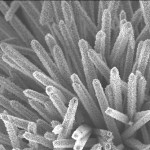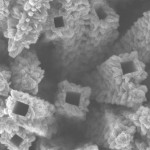
A cover story in the September issue of Small, a prestigious nanotechnology journal, features a method developed by UConn chemistry professor Steven Suib for the production of a nano-sized crystalline material that will be used for energy conservation.
“The cover of Small is highly coveted,” says Bernhard Rügemer, production manager. “It is instantly recognizable, and associated worldwide with the highest quality research from the top researchers in the field.”
The issue, to be published next month, reports on basic science research into a new material that could be used as a catalyst in alternative fuel development.
The nanomaterial, developed using Suib’s method, is tiny – smaller by far than even the head of a pin – and consists of two materials, one a template and the other a material that can grow around it in a well-ordered array. The growth can be controlled and uses solar energy to drive reactions such as the splitting of water into hydrogen and oxygen.

The material can be a component of paint or can be applied to a surface, and will be useful in solar applications, says Suib, head of the chemistry department in the College of Liberal Arts and Sciences. The material acts as a catalyst in a process chemists call photocatalysis, which is the acceleration of a photoreaction in the presence of a catalyst.
One of the amazing things about the work is its incredibly small size – 100 nanometers. “It’s very hard to make materials this size,” Suib says, “as small antennas come in and out of a surface that small.”
Having an article published in Small is important, because the publication is read by materials scientists, chemists, physicists, engineers, and experts on nanoparticles all over the world.
The article was published online in May.


